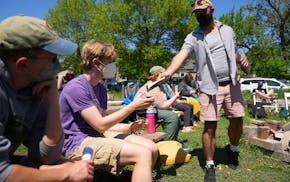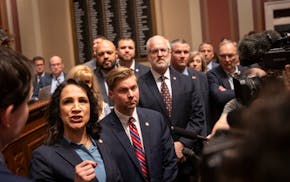In a desolate crook of south Minneapolis bounded by Interstates 35 and 94, a three-story building housing people emerging from homelessness began its collapse in early 2022.
A large encampment emerged in a vacant lot next door to the building known as the Dundry House, and soon there were significant problems with vandalism, including the theft of the building's pipes. Hope Community, the Dundry's nonprofit owner, spent about $24,000 a month on security — canceling out the $23,000 it generated in monthly rent.
By mid-2023, Hope relocated tenants, boarded up the Dundry and searched for another affordable housing provider willing to buy it. But after two fires, including a major blaze this April, the building was condemned; last month, it was demolished.
Reduced to rubble were 25 units of deeply affordable housing stock meant to keep some of Minneapolis' most vulnerable people off the streets — providing a case study in what happens when constructing new affordable housing is prioritized over maintaining older buildings.
Will Delaney, Hope's co-executive director, said what happened at the Dundry is an extreme example of systemic failures in how Minnesota finances affordable housing for the poorest tenants.
Various government agencies are pouring money into new housing without sufficiently funding the operation of existing buildings, Delaney and other affordable providers said. As a result, buildings in marginalized neighborhoods with high crime rates, serving communities hardest-hit by the opioid crisis, see security expenses outpace their initial financial assumptions at an unsustainable clip.
Part of the difficulty is how Minneapolis' encampment closure practices often result in people with limited options simply moving around to different sites, Delaney said. Meanwhile, Hennepin County's Coordinated Entry system of housing homeless people in order of greatest need inadvertently leaves units vacant for long periods of time as caseworkers meticulously match individuals with homes. Those vacancies mean lost rental revenue for those housing providers operating on razor-thin margins.
As a result, housing nonprofits face hard decisions about how long they can maintain older buildings, even as they open new complexes elsewhere to the confusion of tenants awaiting essential repairs.
"Essentially, the way the model works is you get a subsidy to build it and keep your rents lower, but particularly in an environment with high inflation, higher costs with security, especially when you're dealing with folks who might have higher needs, the rents don't pay for upkeep," Delaney said.
"It is really difficult, if not impossible, to get money to support operations."
Various government agencies provide gap funding for affordable housing development, touting record rates of construction in recent years. But there's no central tracking of the affordable units lost or vacated because of disrepair and conversion to market-rate housing.
"A lot of providers are starting to have these very difficult conversations about this unfortunate bind, that in order to keep their mission and keep their organization focused, they actually have to reduce their footprint to save the rest," said Caroline Hood, CEO of RS Eden, which operates 630 units of permanent supportive housing for people in recovery programs and re-entering society after prison.
"It's such a terrible position to be in for our community, as those affordable units would go away and likely become market-rate, which only perpetuates the housing issues that we see."
When buildings fall into disrepair, tensions flare among affordable housing providers, existing tenants and the surrounding neighborhood. No organization wants to tell the public they're in dire straits, Hood said. But a coalition of providers, including CommonBond, Project for Pride in Living and Hope Community, are raising the long-term unsustainability of imbalanced financing for affordable housing as a sector-wide problem unsolvable with private fundraising alone.
"None of us sign up for these deals to make money. We're just trying to make the math work to make a building possible so we can serve residents," said Chris LaTondresse, CEO of Beacon Interfaith.
The nonprofit Beacon Interfaith has 750 units of permanent supportive housing serving youth, families that have been involved with the child protection system and people exiting encampments with histories of mental health and addiction.
LaTondresse, a former Hennepin County commissioner, said he wished he had greater awareness of the need for operating support alongside new construction capital when he was a policymaker. Last year, the Lonoke, a Beacon building in Stevens Square, underwent the same sort of compounding crises of squatters, drugs and soaring security costs and deferred repairs that the Dundry had experienced.
In many cases, people who were doing well before the pandemic have recovered economically, LaTondresse said. But those who were struggling are doing worse, needing more services and rent assistance even as Beacon and its peers are dealing with declining revenue and growing expenses.
"At all levels of government, but especially at the state and with local governments that do housing work, we need a rebalancing of priorities that, against the backdrop of our housing crisis continues to prioritize new housing production, but alongside of that brings dollars to draw a circle of protection around the units that already exist in our ecosystem," he said.
Hennepin County offers low-interest deferred loans for the preservation of affordable housing. The city doesn't fund ongoing maintenance. But when the Dundry went under, just five years after $2 million in public funding was spent rehabbing the building, Minneapolis and county forgave more than $1 million of their loans.
Last year, the Legislature passed a historic $1 billion investment in affordable housing, including $50 million in one-time funding to help nonprofit providers continue operating properties that don't generate enough rent revenues to cover costs. The relief helped but wasn't enough to truly stabilize buildings.
This year, the Legislature approved another $50 million for the preservation of existing housing and created a task force to further explore the topic.
Commissioner Jennifer Ho of Minnesota Housing, the state's housing finance agency, said while there remains a great need for more construction of affordable housing, the task force should try to establish shared facts around what's killing existing buildings and which of those drivers are temporary versus permanent shifts in projects' financial presumptions.
"The fact is that the amount of public resources ... even with a huge year like last year, still feel horribly finite compared to what we need to do," Ho said. "I'm really hopeful about our ability to think more clearly about our work and think about it systemically, to think about how the future of affordable housing could be a more stable endeavor."

Want to share info with the Star Tribune? How to do it securely

'Safe recovery sites' would offer syringes, naloxone and more to people using drugs. The plan could be in peril.
New Minnesota GOP leaders seek peace with party's anti-establishment wing

Who is Republican Lisa Demuth, Minnesota's first House speaker of color?



